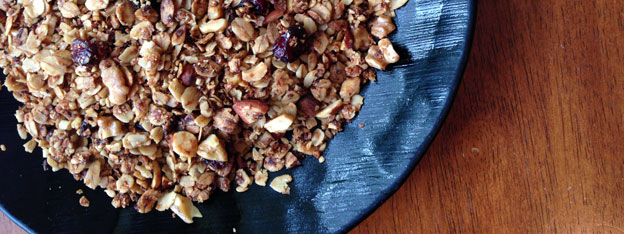Score one in my column. For years, my family insisted on eating bagels most weekday mornings. In terms of nutrition, bagels are more or less Jewish Wonder Bread: tasty but empty calories. There just aren’t a whole lot of health benefits in poppy seeds and sesame seeds. But they rejected other, healthier choices, like whole wheat toast and whole wheat bagels. The price of bagels has steadily increased over the years, and because I buy them by the dozen, that’s almost $10 a week! I’m cringing even as I type this…. I feel like I’m channeling my mother complaining, “Ah-ya! I remember when bagels were 4 for a $1!” But it’s not just about the cost, Ma, really! There just had to be a better way.
This is where granola takes the stage (skip the chit chat, and go straight to the recipe). I resisted making granola for years. We all love it, but I don’t usually buy it at the grocery store, because it doesn’t feel like a great value. After all, granola essentially is oatmeal minus water, but making it felt like too much work. Not that I actually knew how much work it would be since I’d never made it. Well, I must have had 10 free minutes on my hands in February, because I finally rolled up my sleeves and did it! I had all the ingredients on hand. It turned out to be easy and delicious! And everyone ate it the way people eat Cracker Jacks. I’ve made a handful of batches since then, refining the original recipe to get the perfect balance of toasty nuttiness and sweetness. The DH has switched to eating my homemade granola with milk on weekday mornings, and the DD and DS make homemade yogurt parfaits with the granola, fruit, and plain yogurt. We all eat it straight up or with milk as a snack, too.
What was my mental block against making granola about? Maybe it was an unconscious resistance to shedding another token of my New York City girlhood. I know, there are lots of “iconic” New York foods—it’s a big city—but bagels are it for me. In its place, insert granola, a (tie)dyed-and-true Northern California hippie emblem. Heck, I’ve only been living here for 20+ years. Probably not, but don’t you love the symbolism of it?
OK. Crazy Foodie time: does making my own granola actually save money? I did a bit of calculating to find out. There are about 8 ½-cup servings in one pound of granola; that’s $5.79 for 4 cups. My granola cost $8.65 for 7 cups—see my calculations below (the only ingredient I didn’t include in the cost analysis is salt)—or $4.94 for 4 cups, which is 17% less than the store-bought stuff. Of course, that doesn’t include cost for energy, water and detergent, or my labor. [Update: this cost analysis was based on an earlier version of my recipe. I've since substituted brown sugar for the honey, and I now add fewer nuts and dried fruits, which should bring the cost for ingredients down.] When it’s all said and done, it’s not a huge cost savings, but now that I know how easy it is to make, I’m going to keep making my granola anyway (and the kids are helping out, too!)—it just tastes better when it’s homemade.
Recipe: Granola
Makes about 10 cups
Ingredients
- 4 cups rolled oats
- 1 cup steel cut oats
- 1½ cup raw wheat germ
- ⅜ cup flax seeds
- 1¾ cups chopped raw nuts (almonds, walnuts, or pecans)
- ½ cup brown sugar
- ¾ teaspoon salt
- ¾ cup canola oil
- 1½ tablespoon vanilla extract
- 1½ cups mixed dried fruit (cranberries and raisins)
Preparation
Preheat oven to 325°F with the oven rack in the middle of the oven. Line 2 roasting pans with parchment paper.
In a large bowl, stir together the first 7 ingredients (all the dry ingredients except the dried fruit). Stir well to combine. Add the oil and vanilla, and stir again. Spread the granola evenly onto the roasting pans.
Bake the granola for 30-35 minutes, stirring every 10 minutes and switching the position of the pans each time. The granola is done when it is golden brown and fragrant. Mix in the dried fruit as soon as the granola comes out of the oven, then allow the granola to cool completely in the roasting pan. Store granola in an airtight container. Granola can be frozen.

